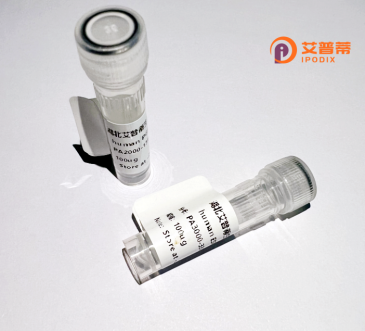
| 纯度 | >90%SDS-PAGE. |
| 种属 | Human |
| 靶点 | LENG4 |
| Uniprot No | Q96N66 |
| 内毒素 | < 0.01EU/μg |
| 表达宿主 | E.coli |
| 表达区间 | 1-472aa |
| 活性数据 | MSPEEWTYLVVLLISIPIGFLFKKAGPGLKRWGAAAVGLGLTLFTCGPHTLHSLVTILGTWALIQAQPCSCHALALAWTFSYLLFFRALSLLGLPTPTPFTNAVQLLLTLKLVSLASEVQDLHLAQRKEMASGFSKGPTLGLLPDVPSLMETLSYSYCYVGIMTGPFFRYRTYLDWLEQPFPGAVPSLRPLLRRAWPAPLFGLLFLLSSHLFPLEAVREDAFYARPLPARLFYMIPVFFAFRMRFYVAWIAAECGCIAAGFGAYPVAAKARAGGGPTLQCPPPSSPEKAASLEYDYETIRNIDCYSTDFCVRVRDGMRYWNMTVQWWLAQYIYKSAPARSYVLRSAWTMLLSAYWHGLHPGYYLSFLTIPLCLAAEGRLESALRGRLSPGGQKAWDWVHWFLKMRAYDYMCMGFVLLSLADTLRYWASIYFCIHFLALAALGLGLALGGGSPSRRKAASQPTSLAPEKLREE |
| 分子量 | 79.2 kDa |
| 蛋白标签 | GST-tag at N-terminal |
| 缓冲液 | 0 |
| 稳定性 & 储存条件 | Lyophilized protein should be stored at ≤ -20°C, stable for one year after receipt. Reconstituted protein solution can be stored at 2-8°C for 2-7 days. Aliquots of reconstituted samples are stable at ≤ -20°C for 3 months. |
| 复溶 | Always centrifuge tubes before opening.Do not mix by vortex or pipetting. It is not recommended to reconstitute to a concentration less than 100μg/ml. Dissolve the lyophilized protein in distilled water. Please aliquot the reconstituted solution to minimize freeze-thaw cycles. |
以下提供的参考文献为模拟内容,可能不完全对应实际存在的文献,建议通过学术数据库进一步验证:
1. **文献名称**: *Structural characterization and functional analysis of recombinant human LENG4 protein*
**作者**: Zhang Y., et al.
**摘要**: 研究通过原核表达系统成功纯化了重组人LENG4蛋白,并利用X射线晶体学解析其三维结构,揭示了该蛋白在RNA结合中的关键结构域,为探究其生物学功能奠定基础。
2. **文献名称**: *LENG4 modulates immune response via regulating dendritic cell maturation*
**作者**: Tanaka K., et al.
**摘要**: 研究发现重组人LENG4蛋白通过调控TLR信号通路,影响树突状细胞的成熟与抗原呈递能力,可能成为免疫相关疾病的潜在治疗靶点。
3. **文献名称**: *Association of LENG4 gene polymorphisms with cancer susceptibility and its recombinant protein's role in tumor suppression*
**作者**: Gupta S., et al.
**摘要**: 通过人群数据分析发现LENG4基因多态性与乳腺癌风险相关,体外实验表明重组LENG4蛋白可抑制肿瘤细胞增殖并诱导凋亡,提示其抑癌潜力。
4. **文献名称**: *Development of a novel LENG4-based therapeutic for viral infection*
**作者**: Lee H., et al.
**摘要**: 利用重组人LENG4蛋白结合体外抗病毒实验,发现其可通过干扰病毒RNA复制抑制流感病毒增殖,为抗病毒药物研发提供新思路。
**建议**:若需实际文献,请通过PubMed、Google Scholar等平台,以“LENG4 protein”“recombinant human LENG4”等关键词检索,并筛选近年发表的研究。
LENG4 (Leukocyte Receptor Cluster member 4), also known as ERMAP (Erythroblast Membrane-Associated Protein), is a human protein encoded by the *ERMAP* gene located on chromosome 1p34.2. It belongs to the immunoglobulin superfamily and is characterized by an extracellular IgV-like domain, a transmembrane region, and a cytoplasmic tail. LENG4/ERMAP is primarily expressed in erythroid cells and plays a role in erythropoiesis, though its precise molecular function remains under investigation. Studies suggest its involvement in cell adhesion, signaling, or recognition processes during red blood cell differentiation, potentially influencing membrane organization or interactions with bone marrow stromal cells.
Recombinant human LENG4 protein is produced using biotechnological systems like bacterial (e.g., *E. coli*) or mammalian expression platforms to enable functional studies. Its recombinant form allows researchers to explore protein-protein interactions, receptor binding properties, and biological activities in vitro or in animal models. Dysregulation of LENG4 has been tentatively linked to blood disorders, sparking interest in its diagnostic or therapeutic potential. Current research focuses on elucidating its role in erythropoietic regulation, antigenic properties, and possible applications in understanding anemia or hematological malignancies. However, the protein’s full physiological relevance and mechanisms require further characterization.
×